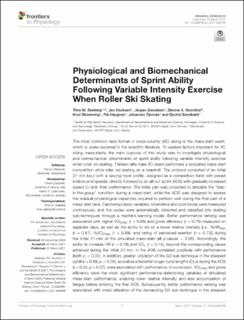| dc.description.abstract | The most common race format in cross-country (XC) skiing is the mass-start event, which is under-explored in the scientific literature. To explore factors important for XC skiing mass-starts, the main purpose of this study was to investigate physiological and biomechanical determinants of sprint ability following variable intensity exercise when roller ski skating. Thirteen elite male XC skiers performed a simulated mass-start competition while roller ski skating on a treadmill. The protocol consisted of an initial 21-min bout with a varying track profile, designed as a competition track with preset inclines and speeds, directly followed by an all-out sprint (AOS) with gradually increased speed to rank their performance. The initial part was projected to simulate the “stay-in-the-group” condition during a mass-start, while the AOS was designed to assess the residual physiological capacities required to perform well during the final part of a mass-start race. Cardiorespiratory variables, kinematics and pole forces were measured continuously, and the cycles were automatically detected and classified into skating sub-techniques through a machine learning model. Better performance ranking was associated with higher VO2Max (r = 0.68) and gross efficiency (r = 0.70) measured on separate days, as well as the ability to ski on a lower relative intensity [i.e., %HRMax (r = 0.87), %VO2Max (r = 0.89), and rating of perceived exertion (r = 0.73)] during the initial 21-min of the simulated mass-start (all p-values < 0.05). Accordingly, the ability to increase HR (r = 0.76) and VO2 (r = 0.72), beyond the corresponding values achieved during the initial 21-min, in the AOS correlated positively with performance (both p < 0.05). In addition, greater utilization of the G3 sub-technique in the steepest uphill (r = 0.69, p < 0.05), as well as a trend for longer cycle lengths (CLs) during the AOS (r = 0.52, p = 0.07), were associated with performance. In conclusion, VO2Max and gross efficiency were the most significant performance-determining variables of simulated mass-start performance, enabling lower relative intensity and less accumulation of fatigue before entering the final AOS. Subsequently, better performance ranking was associated with more utilization of the demanding G3 sub-technique in the steepest uphill, and physiological reserves allowing better-performing skiers to utilize a larger portion of their aerobic potential and achieve longer CLs and higher speed during the AOS. | en_US |

